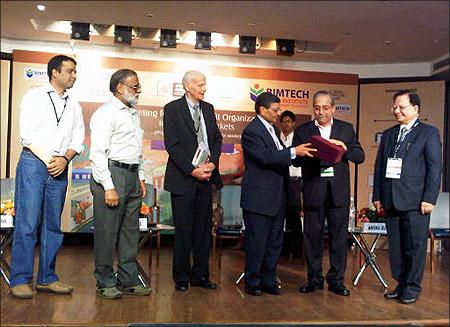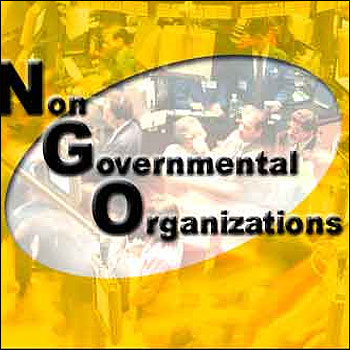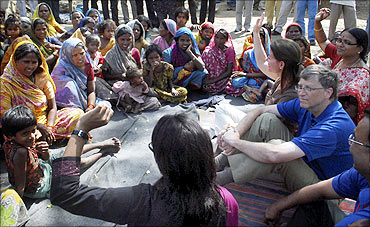"The best way for NGOs is to embrace marketing instead of confusing it with just selling (to the donors). They have to deliver value by creating the four 'A's of marketing," said marketing guru Jagdish N. Sheth, while speaking at the 6th Indian Marketing Summit in New Delhi.
Birla Institute of Management Technology (BIMTEC) organized the 6th Indian Marketing Summit at India International Centre in New Delhi. The 2 day workshop was conducted on April 27-28, 2012.
What attracted me to the workshop was the theme of the workshop, 'Marketing for not for profit organizations in emerging markets'.
The panel of speakers were absolute heavyweights from the corporate and academic world.
The father of rural marketing in India, Pradeep Kashyap was there along with Alan R Andreasen who is the Chair Professor at McDonough Scool of Business of Georgetown University and Executive Director of the Social Marketing Institute. He is the author of the widely acclaimed book titled 'Social Marketing in 21st Century'
There were great achievers from the 'Not for Profit' sector who attended the seminar.
Ian Correa of HOPE; Ramesh Ramanathan of 'Janaagraha Centre for Citizenship and Democracy; Kauhshlendra, the IIM graduate who has brought about a mini revolution in districts of Bihar with unique 'farm-to-kitchen' model of vegetable distribution; Anshu Gupta, of GOONJ, the NGO which gives dignity to the most marginalized section by solving their clothing problems; Kalyan Paul of Pan Himalayan Grassroots Development Foundation and Irfan Alam, the founder of Sammaan foundation which works for the welfare of cycle rickshaw pullers were all there at the seminar.
The biggest star of the seminar was undoubtedly Dr. Jagdish N. Sheth, the Marketing Guru and the founder of the Academy of Indian Marketing and the Chair professor of Marketing in the Goizueta Business School at Emory University. He was felicitated by BIMTEC at the seminar and his speech was heard in rapt attention.
Text and photograph contributed by Sudhir Bisht.
...
How to make NGOs successful
Excerpts from Dr Sheth's speech:
On NGO sector growth in Asia
Civil society is the 3rd leg of the society. It is variously called as the 'Not for Profit organization ' or 'non-government organization' and is going to be much more bigger in the near future.
There is a clear difference between the way China is organizing for the growth of the NGO sector and the way India is organizing itself for the same.
The largest NGOs in the world by 2020 will be all of Chinese NGOs. They will dwarf most of the largest American NGOs, not the American Foundations but the NGOs, like the American Red Cross and the United Way Worldwide.
Raising $ 5 billion annually, United Way is the largest privately-supported nonprofit organization in the world.
NGO sector in China is a very, very serious government led initiative and is extremely mission driven.
In contrast, in India, the NGO market is primarily grassroots evolution. It is often led by individuals who have passion for a cause and very often it is the corporate executives who are going through a middle life crisis and they set up NGOs.
These corporate executives have done successfully well in their careers and are searching for the meaning of life. They have reached a point in their careers when they feel that what they are doing in their careers is not satisfying.
May be because of the way they are started, their approach to organizing and strategizing is very different. The approach of Chinese NGOs can be compared to a Christian wedding. Everything is planned around 18 months in advance.
The place is identified, the priest is identified the wedding guest list, the sequence of events at the wedding and everything else is planned to the minutest detail and the execution is almost always as per plan. There are no surprises.
In contrast, the Indian NGO can be compared to an Indian wedding. It is like a great mela. Lot of excitement, hustle and bustle, very fascinating but very chaotic. Things do happen eventually though.
Which approach is the best approach for the evolution of the 3rd leg of the society, we don't know. The first is the orchestrated approach to organizing the NGO and the second is like improvisation at every step.
...
How to make NGOs successful
Image: Indian rupee notes.Photographs: Reuters.
Private Equity is concerned with just investor's interest
I have written a book with my colleague Rajendra Sisodia. It is called the 'Firms of Endearment'. Many years ago I was absolutely unhappy with the notion of raw capitalism. The companies in the early 80s became so much shareholder driven that they completely overlooked all the stakeholders.
Most of this happened due to the pressure from the private equity guys. After the first energy crisis of 1974-76, when the stock market wasn't doing well, the private equity guys took up large corporations and broke them up into values in the early 80s.
There were many ruthless private equity organizations like the KKR which inspired the movie called 'Barbarians at the Gate' and there were some benevolent private equity players like Warren Buffet but the important feature of all Private equities was that the shareholders interest was the only interest to be protected. I began to question this.
Share of Heart: The Best cos are not listed. Stock markets corrupts
When I and my research colleagues started with the concept of the 'share of heart' as a way of marketing, as opposed to only working towards the 'wallet share', we were very clear that the 'share of the heart' belonged to the five stakeholders, the customers, the employees, the community, the suppliers and of course the investors. We did research using the secondary data of 200 companies and finally we did an in depth research of 30 companies.
...
How to make NGOs successful
Image: Dollar notes.Photographs: Reuters.
We found that the best 30 companies were private enterprises and they were not listed companies as the stock market corrupts the companies.
In large publicly held organizations, the CEO doesn't know how long he will last. The budgeting is annual. The CEOs live in Ivory towers.
The presentations that are made to them are first vetted by many layers of Vice Presidents and the CEOs of large companies are far removed from the realities of business. The main time of the CEO is spent on keeping the Board happy.
The Board is happy with the CEO in Quarter I and they become disenchanted with the CEO by the III Quarter. We have found that the privately held companies generally perform better than the publicly held company.
A company with real 'share of hearts' are located in small towns.
In America, if your company is away from the big cities, the owner of the business has to live closely with his employees in social life. The owner has to attend the same Church and the children of the owner are friends with the children of the employees and managers. They are the neighbors of the owners.
In Benton Harbor, Michigan which headquarters the Whirlpool Corporation, I found that everyone in the town knew Jack Sparks, the Chairman and the CEO by the first name.
Unfortunately as the companies become bigger and they move to big cities, the owners started to live in a gated community. They have no time to mingle with the other stakeholders, except the investors.
People feel that the academicians live in the ivory towers but I find that the CEOs live in the ivory towers really!
To correct this disconnect between the CEOs and the stakeholders, we recommend that the Top management spends one-third of their time, away from the office. They should meet the employees, the customers, the suppliers and the communities and not just the investors.
Our research of 15 years of the 30 companies reveal that the companies which have lasting success stories are the one who look after all the five stakeholders of business and not just look after the investor, who by the way is also an important stakeholder.
...
How to make NGOs successful
Photographs: Reuters.
The 4 As of Marketing
We have done 600 case studies of all marketing organizations over 6 to 8 years. Unlike 4 Ps of Marketing (Product, Price, Place and Promotion) which takes care of market thrust perspective, the 4 As take care of the customer perspective.
The four As are Acceptability, Affordability, Availability and Awarenes The four As define the customers' perspective, what the customers are looking for. Coca Cola as a company was founded on the principles of the 4-As.
The strongest 'A' of Coca Cola wasn't Acceptability of its recipe of its drink but rather the Availability.
In the most remote parts of the world you will get a bottle of Coca Cola. The NGO sector would do well if it learns from Coca Cola Melinda Gates has a 20 minute video which you must look for.
She talks about how the 'not for profit' organizations should learn from 'for profit' organizations and she singles out Coca Cola's accessibility in the rural most parts of Amazon in Brazil.
NGOs need to learn the aura that Coca Cola creates around its packaging. NGOs can learn the marketing aspect of business from the corporate sector while being strictly driven by their core mission of not for profit.
Affordability is another A where Coca Cola scores very well. They ensure that their price point is always affordable to its customers.
The NGO sector's biggest problem is the 4th A, the 'Awareness' One of the biggest problems with the NGOs is that nobody knows that they exist.
I and my wife give away everything that we earn. We have two foundations of our own. I had no idea about the large NGO in Indian called Akshay Patra. I had no idea about how good they were till I went to Rajasthan about two years ago. Today it is run like a business. The supply chain management is so good that you really are in an awe that an NGO can perform so well.
This is excellence on the operations side but not on marketing side. I didn't know that they serve two and a half million school children mid day meal, six days a week.
We have got involved with them now. We did a fund raising and in one night we raised quarter of a million Dollars! Narayana Murthy too feels that it is a great NGO, with a great cause but he feels that it needs to be ensured that they perform like a business in terms of efficiency and scale.
...
How to make NGOs successful
Image: People carry pots containing water on their heads on the outskirts of Mathura.Photographs: K K Arora/Reuters.
This scale is just the tip of the iceberg.
Family Planning Programmes (Not for Profit) & for profit corporate
I came to India (from America) in 1968. I was in IIM Calcutta as a visiting Professor and one of the projects that I did was in population control. The government was convinced that the population growth rate had to be controlled but the challenge was that of communication in rural India. The problem was how to communicate.
No contraception or controls were allowed on the women's side. No birth pills were allowed and no ligation (tubal ligation) was allowed. And hence only condoms and male vasectomy were the only options available.
In Calcutta, a mobile van with a Doctor and an attendant used to do 100 vasectomy operations in a day. Think about the scale that family planning programme achieved then.
How did the Family planning achieve such good results? How did they achieve awareness? In villages, every man believed that if he had 4 sons, he was the king. In a village the small boys become the errand boys very early in their life.
The do errands between the home and the farm when they are small and by the time they are into their teens they become full fledged labour force. And when you grow old, they (the sons) take care of you! After all there is no pension or social security available to them.
By a purely mathematical analysis, the more the children, the more your assets. So awareness was a challenge. To tell the farmer that less number of children was beneficial to him was a challenge.
By the way do you know the cost of an American child to the parents, assuming that the child will have four years of college education, is $250,000. And what do these children give you? They give you heartache and headache!
The birth rate did decline in India in the urban areas.
From above 4 children per woman to less than 1.9 per woman. In the rural India, the per woman children number is still around 4 during her cycle of fertility.
So the challenge in Family Planning Programme was how to make the people aware that more children weren't good for them and even if they were convinced, how to take care of the mechanism. That's where I worked and this as a Ford Foundation funded project.
It was a challenge to carry the condoms all the way to rural India. India was becoming the anti- Western nation at that time and it was found that the multinationals which were in India could be pressurized to help the cause of family planning. Isn't it interesting that on the Indian corporations there was no pressure.
So Brook Bond Tea which had a formidable distribution all across India was roped in and the family planning story rode on the bicycles of the Brook Bond distribution network to distribute condoms.
Coca Cola and ITC cigarettes also were forced to distribute condoms through their distribution channels.
So accessibility and affordability are two quick ingredients of NGO marketing that I have learnt over time
...
How to make NGOs successful
Image: Bill Gates and his wife Melinda interact with slum dwellers during their visit to a slum area in Danapur, Bihar.Photographs: Krishna Murari Kishan/Reuters.
The way forward for Not for Profits Organizations
The mission of the NGOs is social but they have to behave like business. Most NGOs operate in the services sector. For the NGO, the purpose is more central to the mission than profit.
In for NGO the funding comes less from the customers and more from third party payers such as donors and governments. And this could run into a huge conflict because in some cultures, the donors believes that since they are giving money the NGOs will have to obey them. This isn't philanthropy in the true sense if the donors want to control the NGO.
In American Cancer Society for example, the donors are more powerful than the managers. How to ensure that the money is transferred from the donor to the NGO but the money doesn't control what the NGOs purpose is all about? How to ensure that the NGO don't indulge in favoritism which the donors want them to do?
These are the challenges of NGO and I think that NGOs don't embrace marketing which could be a solution to these problems. The reason is that marketing somehow seem to be linked with profiteering and the second reason is that NGOs confuse marketing with selling.
The Best way for NGOs is to embrace marketing instead of confusing it with just selling (to the donors). They have to deliver value by creating the four As of marketing.
Generally NGO are very good at creating Acceptability but they aren't good at affordability, availability and awareness parameters.
Not for Profit Organization can do well to learn the marketing skills of 'for profit companies' while remain true to their main cause.
Sudhir Bisht is the Director/CEO of Clairvoyant Corporate Solutions. He is also a prolific writer in business and social matters. Send feedback at sudhir_bisht@rediffmail.com








article